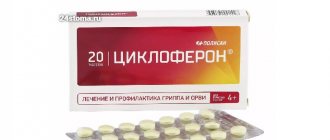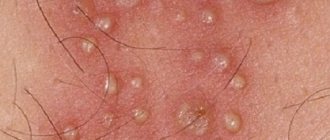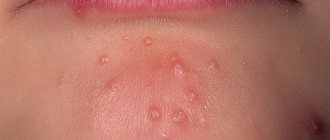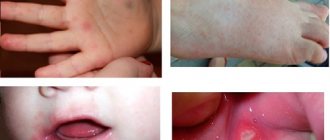Symptoms of measles in children (photos), treatment and prevention measures
Measles is one of the representatives of acute, highly contagious viral infections, characterized by inflammatory reactions in the mucous membranes of the oral cavity, conjunctiva and respiratory organs, accompanied by very high temperatures, intoxication symptoms, macular and papular rashes (see photo).
The causative agent of the disease is a filterable, negligible varion belonging to the Myxovirus family. It does not have high resistance in an open environment and dies quickly outside the body. A child can become infected with measles through contact with a carrier of the infection at the very peak of its infectiousness, several (3-4) days before the onset of the rash.
How does measles spread?
The virus spreads through the air, the current from which can even reach another floor through ventilation pipes. In a closed, cramped room, it easily affects the respiratory tract, mucous membrane of the throat and eyes. It also enters the body with droplets of saliva from a sick person when he sneezes or coughs. Sunlight quickly kills the measles virus. Disinfection of the room in which sick children were located is not required; good ventilation is sufficient, since the lifespan of the virus is only 2-3 hours at normal temperature.
If a child is not vaccinated on time, then in close contact with a sick person he will definitely get sick. The virus reaches its peak development towards the end of the incubation period and over the next few days. It is at this time that the patient is contagious to others and should not have contact with other children or attend kindergarten or school.
The measles virus, during its life processes, produces toxic substances that poison the body of children. A symptom of measles is a characteristic red rash on the face and body.
Effectiveness of vaccination
The WHO estimates that in 1980, before widespread vaccination, there were 2.6 million deaths from measles. In 2014, about 85% of all children worldwide received one dose of measles vaccine during their first year of life as part of routine health care, up from 73% in 2000.
Accelerated immunization efforts have had a significant impact on reducing measles deaths. In 2000-2014 Measles vaccination prevented an estimated 17.1 million deaths. Global measles deaths fell 75% from 544,200 deaths in 2000 to 114,900 deaths in 2014, making the measles vaccine one of the most beneficial public health advances.
Illness in early childhood
Features of the course of measles in young children:
- Children under three months of age cannot become infected with measles - this is due to the fact that their mother passed on her immunity to them at birth. The woman herself was either vaccinated against measles or had it.
- Passive immunity, which lasts up to 6 months, protects infants at this age and they become infected extremely rarely.
- For early childhood, the atypical form of measles is more typical. There is a shortened catarrhal period, mild symptoms, the absence of Filatov-Koplik spots and enanthems on the oral mucosa. Sometimes the incubation period is replaced by a rash, and the catarrhal period is completely skipped.
- Although the symptoms in early childhood are not as severe, measles often causes complications. This is due to the fact that a weak immune system does not always know how to fight back a powerful virus that suppresses all the body’s defenses.
Pathogenesis
Incubation period (8-17 days). Penetration of the virus into the epithelial cells of the mucous membranes of the oropharynx and nasopharynx, conjunctiva of the eyes, upper respiratory tract, and gastrointestinal tract. Replication of the virus in the area of the entrance gate of infection with the formation of symplasts. Lymphogenic dissemination with an increase in the number of foci of virus replication in the area of the entrance gate. Sensitization of the macroorganism.
Initial period (catarrhal) period, 3-4 (up to a day. Immune-mediated cytolysis of epithelial cells contaminated during the incubation period in the area of the entrance gate. Release of pro-inflammatory cytokines. Development of intoxication, respiratory (rhinitis, pharyngitis, laryngitis, tracheitis, bronchitis) syndromes, conjunctivitis, appearance enanthema Viremia Hematogenous dissemination of the virus with the formation of secondary foci of virus replication, including in the mucous membranes of the upper respiratory tract, gastrointestinal tract, epithelium of the Malpighian layer of the skin of the face, trunk and limbs, and extremely rarely in neuroglia.
The peak period (rash period) is 3-4 days. Continued viremia. Immune-mediated cytolysis in secondary foci of viral replication - including, successively, the scalp, neck, trunk, and extremities. Gradual (“top to bottom”) spread of exanthema. An increase in intoxication and respiratory syndromes, and the possible appearance of diarrhea. Manifestation of the immunosuppressive effect of the virus. Formation of “measles anergy”. Anergy is manifested, among other things, by the disappearance of skin allergic reactions to tuberculin and toxoplasmin in infected individuals. Risk of bacterial complications.
The convalescence period (pigmentation period) is 5-8 days. Further formation of immunity. Elimination of the virus. Desquamation, pigmentation of the skin epithelium. Reparative processes in target organs.
Measles symptoms, photo
Oddly enough, even the most perceptive parent will not see how measles begins (see photo). This insidious disease develops in stages, and the initial period can last weeks and not manifest itself at all. The child will continue to have fun and play, and at the same time the harmful virus will undermine his body from the inside.
1) Incubation period of childhood measles: 7–14 days (counted from the moment of infection until the immediate appearance of the first symptoms).
2. Catarrhal period, when children show the first signs of measles, reminiscent of all the symptoms of a cold:
- general malaise;
- lack of appetite;
- severe weakness;
- headache;
- insomnia;
- temperature 38–40°C;
- runny nose with purulent mucous discharge from the nose;
- swelling, redness of the eyelids;
- lacrimation;
- dry, persistent cough;
- conjunctivitis (purulent inflammation of the eye mucosa);
- loose stool;
- hoarse voice;
- photophobia;
- stomach ache;
- Children under one year of age often experience a decrease in body weight.
3. The main symptoms of measles in children (almost three weeks after the first signs of the disease):
- grayish-whitish small rashes (the size of a poppy seed) in the mouth, on the mucous membrane opposite the molars;
- after another 5 days, bright, merging spots appear (size - up to 10 mm), slightly rising above the skin: they begin to appear first behind the ears, on the forehead, then on the rest of the face, neck, then throughout the body, in lastly - on the arms and legs;
- small pink spots rapidly increase in size, merge, and take on an awkward, irregular shape;
- 3 days after intense rashes, the temperature rises again (in most cases) to 40.5°C.
The rash covers the child’s body for an average of 4 to 7 days; at first, it leaves brownish pigment spots that begin to peel off; after another couple of weeks, the skin completely clears. The rash disappears in exactly the same order as it appeared - from the face to the extremities. This is how measles manifests itself at different stages of its development: you need to know about this so as not to confuse the disease with other infectious diseases (with the same cold), not to self-medicate, and to show your child to the doctor in a timely manner.
Classification
Measles can be very severe and require emergency care. It is important to know that the disease can be not only typical, but also atypical:
- Mitigated (weakened) measles. The disease develops in people who were administered anti-measles gamma globulin at the very beginning of the incubation period for the purpose of prevention. It is less common in previously vaccinated individuals who have not developed a full immune response. In this form of the disease, intoxication and catarrhal symptoms of measles are mild, the rash is faint and not abundant, Belsky-Filatov-Koplik spots are often absent.
- Abortion measles. It begins in the same way as a typical form of measles. But the temperature lasts no more than two days. Skin rashes are observed only on the head and torso and do not affect the limbs.
- Hemorrhagic measles. An extremely severe form of the disease that can be fatal. It is characterized by a rise in body temperature to very high values, severe intoxication, and the appearance of hemorrhages on the skin and mucous membranes. Blood may appear in the urine - hematuria.
- Hypertoxic measles. Body temperature rises to 40–41°C. The general condition is rapidly deteriorating. Signs of cardiovascular failure appear and increase - decreased blood pressure, a sharp increase in the number of heartbeats, pale skin, cold sweat. It is possible to develop neurotoxicosis - a toxic lesion of the central nervous system. Its signs are headache, nausea, repeated vomiting, disturbances of consciousness, and convulsions³.
Measles can be very severe and fatal. Photo: PHIL CDC
Abortive form
The abortive form of measles in a child is one in which, after a catarrhal period, all symptoms disappear by themselves. The rash appears only on the face, sometimes on the neck. There is a latent form of the disease, when the rash does not appear at all, and catarrhal symptoms are mild.
A feature of measles is its ability to become more severe due to the addition of complications. Complications of measles in children occur when bacterial flora is attached. The respiratory tract is most often affected. Pathologies of the respiratory system include purulent tracheitis, laryngitis, bronchitis and pneumonia.
Source of infection
The source of measles can only be a sick person. Even if the incubation period has not yet ended and the patient has not shown any symptoms of the disease, he may already pose a threat to the release of the virus and thereby the possibility of infection for others. People who are asymptomatic are also considered contagious. Persons after vaccination do not pose a danger to others, even if their temperature rises or rashes appear.
Complications
One of the distinctive features of the measles virus is its ability to suppress the immune system, which can cause many complications from a variety of systems and organs. Most often, opportunistic microflora is activated, which was always present in the child’s body, but was successfully suppressed by his immune forces.
Complications can be early and late, caused both by the virus itself (primary) and resulting from the superposition of a bacterial infection (secondary).
Complications from the respiratory system:
- pneumonia;
- bronchitis;
- bronchopneumonia;
- laryngitis;
- pleurisy.
Primary complications caused by the measles virus:
- early measles giant cell pneumonia;
- encephalitis;
- meningoencephalitis;
- subacute sclerosing panencephalitis.
Complications from the central nervous system:
- encephalitis;
- meningitis;
- polyneuritis;
- meningoencephalitis.
Complications from the digestive tract:
- stomatitis (inflammation of the oral mucosa);
- enteritis (inflammation of the small intestine);
- colitis;
- stool disorder due to increased activity of pathogenic microflora.
Complications from other organs and systems:
- conjunctivitis;
- otitis;
- blindness;
- myocarditis.
Complications from the genitourinary system:
- pyelonephritis;
- cystitis.
Unfortunately, some complications, especially from the central nervous system, can be fatal.
Etiology
Measles virus RNA containing a virus of the Paramyxoviridae family, genus Morbillivirus. The morphology of the virus is typical for paramyxoviruses: spherical virions with a lipoprotein envelope and a helical nucleocapsid, represented by one molecule of single-stranded minus RNA, the main nucleocapsid protein N phosphoprotein P and RNA-dependent RNA polymerase.
The outer surface of the virus shell consists of membrane lipids of target cells and glycoproteins (H and F) of the virus, protruding on it in the form of “spikes”.
Glycoprotein H - hemagglutinin, is responsible for the attachment (adsorption) of the virus to the surface of the target cell. The cellular receptor for the measles virus is the complement cofactor, the transmembrane protein CD46, found only on human and monkey cells. It is presented primarily on epithelial cells of the mucous membranes, skin, and neuroglia, which determines the epitheliotropy of the measles virus.
Glycoprotein F - ensures the fusion of the lipid envelope of the virus with the lipids of the target cell wall to form a pore (bridge) necessary for the penetration of the virus nucleocapsid. In addition, it is capable of causing the fusion of affected cells with many intact ones. As a result, symplasts are formed - giant multinucleated non-viable cells in which further accumulation of the virus occurs. Thanks to the mechanism of symplast formation, viruses do not enter the intercellular space, thereby avoiding exposure to virus-neutralizing antibodies.
Adjacent to the inner surface of the virus shell is a matrix or membrane protein, which is called the virion matrix (M). Hemagglutinin H, fusion protein F, membrane protein M, and nucleocapsid protein NP vary in their degree of immunogenicity. Hemagglutinin H is the most immunogenic, membrane protein M is the least immunogenic.
Virions penetrate the target cell without forming endosomes. RNA polymerase is introduced into the cell along with the virus nucleocapsid. Transcription, protein synthesis, and genome replication occur in the cytoplasm. The genome is transcribed by RNA-dependent RNA polymerase into individual mRNAs and the complete plus template for the genomic viral RNA. The newly synthesized genomes interact with the main proteins of the virus, forming nucleocapsids that bind to the M protein and are surrounded by a shell of modified plasmalemma of the target cell. Virions leave the cell by the process of budding.
Infection of T- and B-lymphocytes allows, on the one hand, to explain the development of “immune measles anergy”, on the other hand, the possibility in some cases of infection penetration through the blood-brain barrier with subsequent replication of the virus in the central nervous system with the development of acute encephalitis, meningoencephalitis.
measles virus
Replication of mutant strains of measles virus with a defect in the M protein is accompanied by the accumulation of viral nucleocapsids in infected neurons and glial cells without the formation of symplasts. This leads to long-term persistence of the virus in the central nervous system and can manifest itself in the development of subacute sclerosing panencephalitis 5-10 years after measles with an incidence of 1 in 300 thousand cases.
The measles virus is unstable in the environment and is killed by sunlight and ultraviolet rays within 8-10 minutes. At room temperature it inactivates after 3-4 hours and quickly dies when it dries; at a temperature of 56 degrees it dies after 30 minutes. The virus tolerates low temperatures well for several weeks. Sensitive to the effects of detergents and disinfectants.
The measles virus is cultivated on primary trypsinized cultures of monkey and human kidney cells. It suppresses the mitotic activity of cellular structures and can also have a mutagenic effect on chromosomes.
Diagnostics
When measles occurs in its typical form, it is not difficult to diagnose the disease. The presence of clear signs of measles described above will rule out other diseases. To make a diagnosis of an atypical form of the disease, the patient should undergo a number of additional tests:
- general blood and urine tests;
- blood test for the presence of the virus or nasopharyngeal smears (virological method);
- blood test for antibodies and increasing their titer (serological method);
- carrying out a hemagglutination inhibition reaction, which can indicate the presence of an infectious lesion.
When complications develop, the doctor additionally prescribes other tests. The most common among them are electroencephalography and chest x-ray.
Mortality
In 1980, before widespread vaccination, there were an estimated 2.6 million deaths from measles.
Globally, there were 145,700 measles deaths in 2013—almost 400 per day or 16 per hour. Globally, there were 114,900 deaths from measles in 2014—almost 314 deaths per day or 13 deaths per hour.
In populations with high levels of malnutrition and lack of adequate medical care, up to 10% of measles cases are fatal.
How to treat measles?
There are no special treatments for measles; the body will cope with the infection on its own. Treatment of the child here is symptomatic, which will alleviate the general condition of the patient:
- Antihistamines. Prescribed to relieve swelling of the nasopharyngeal mucosa.
- Antipyretic. It is recommended to use drugs based on paracetamol and ibuprofen.
- Vitamin therapy. With measles, vitamin metabolism is disrupted and the body's protective properties are significantly reduced. Your doctor may prescribe vitamin C and a vitamin complex.
- Cool damp air in the room. Helps moisturize mucous membranes, cough becomes less dry.
- Hygiene procedures. During the recovery period, you can take baths. It is also necessary to carry out thorough oral hygiene and wash the eyes if there is an inflammatory process.
- Diet. After the acute period, when the temperature subsides, the child develops an appetite. Light, pureed, warm food should be offered.
During illness, it is also important to provide the child with the necessary vitamin complexes to maintain immunity, and to lubricate chapped lips with Vaseline.
A patient with measles needs bed rest while the temperature persists. If possible, give him a separate room. Wet cleaning should be carried out at least 2 times a day. It is very important that the air remains fresh at all times, so ventilate the room more often. If bright light causes discomfort, then close the curtains and in the evening turn on a table lamp instead of a chandelier. Follow a daily routine. Although sleep is disturbed and insomnia has appeared, try to go to bed on time. This is especially true for children. If it is difficult to keep your child in bed, then allow him to play quiet games, watch a little TV, or read together. But it is advisable that he sleep after lunch.
Symptomatic treatment is carried out at home under the supervision of a pediatrician. The child is admitted to the hospital department if complications begin to develop. If there are complications, therapy is supplemented with antibacterial drugs.
Features of treatment
Severe complications of measles can be avoided with supportive care that ensures good nutrition, adequate fluid intake and treatment of dehydration with WHO-recommended rehydration solutions. These solutions replace fluid and other important micronutrients that are lost due to diarrhea and vomiting.
There are no specific antiviral drugs for the treatment of measles!
Antibiotics should be prescribed to treat eye and ear infections and pneumonia. All children in developing countries who are diagnosed with measles should receive 2 doses of a vitamin A supplement, given 24 hours apart. This treatment restores the low levels of vitamin A seen during measles, even among well-nourished children, and may help prevent eye damage and blindness. Vitamin A supplements have been shown to reduce measles deaths by 50%.
Symptomatic treatment includes expectorants, mucolytics, and anti-inflammatory aerosols to relieve inflammation of the respiratory tract. In case of pneumonia or other bacterial complications of measles, antibiotics are indicated; in severe cases of croup, corticosteroids are used.
Children with measles are not recommended to take aspirin; aspirin can lead to the development of Reye's syndrome (hepatic encephalopathy up to the development of deep coma due to taking acetylsalicylic acid against the background of a viral infection). Ibuprofen and paracetamol can be used to combat fever and pain.
Diet and nutrition
A few more tips to help defeat measles
- The menu should contain a lot of vegetables and fruits, both raw and stewed and boiled. Vegetable soups with cereals in low-fat meat broth are good.
- Ready-made dehydration solutions Regidron and Humana Electrolyte help restore water and mineral reserves. You can prepare a similar solution yourself by dissolving 1 tbsp in a liter of boiled water. sugar, 1/2 tsp. baking soda and 1 tsp. salt.
- Drink plenty of fluids. The norm for an adult is 2.5-3 liters per day, and for a child 100-150 ml/kg per day. Compliance with this rule helps to remove harmful waste products of viruses from the body, reduce allergy in the body and prevent complications from occurring. You can drink clean water, compotes, juices, fruit drinks, teas.
- Food should be warm, but not hot, so as not to irritate a sore throat. For the same reason, it is desirable that the dishes be pureed and semi-liquid (mashed soups or milk porridges). Such food is easy to swallow without irritating the mucous membrane of the mouth.
- Any semi-liquid porridge is suitable as a side dish: rice, buckwheat, millet.
- Fermented milk products, especially kefir, narine and homemade yoghurts, improve immunity well.
- To strengthen the immune system, you need protein dishes made from lean pureed meat and fish (steamed cutlets, pate or soufflé). As well as omelettes, cottage cheese in its natural form or in a casserole with cereals and berries.
Preventive measures
Prevention of measles in children includes several important points.
- Vaccination. The most effective protection is a vaccine. It can be single-component or multi-component (MMR, or measles, mumps, rubella). The vaccination is carried out at 1 year, then again at 6 years. Up to 10% of vaccinated children may develop a mild form of infection with a minor rash and fever. At this point, children are considered not contagious. Due to the massive refusal of vaccinations in Russia, cases of measles have become more frequent. According to statistics, 80% of children who suffered from this disease were not vaccinated.
- Taking immunoglobulin, or passive immunization. If it is known that the child had contact with a carrier of measles or was in an outbreak of the disease, immunoglobulin can be used, which provides immunity from infection for one month.
- Quarantine. In the children's group where a case of measles was recorded, anti-epidemic measures and daily preventive examination of children are carried out. A child is considered contagious several days before the first symptoms appear, as well as for 5 days after the first skin rash appears. Staying in a children's group is prohibited. Quarantine is carried out only for unvaccinated children under 17 years of age.
Recurrence of measles occurs in extremely rare cases. After an illness, immunity is lifelong. After vaccination, stable immunity remains for 15 years.
Pathomorphology
Typical in the pathomorphology of measles is damage to the epithelium of the mucous membranes and skin with the formation of symplasts, detected in the early stages of the disease. Immune-mediated cytolysis of the affected epithelium leads to destructive and inflammatory processes. Measles is characterized by serous-exudative (catarrhal) inflammation of the mucous membranes of the nasopharynx and oropharynx, larynx, trachea, bronchi, as well as the gastrointestinal tract - plethora, edema with vacuolization of epithelial cells, small lymphohistiocytic infiltrates.
Enanthema on the mucous membranes of the oral cavity, which is pathognomonic for the initial period of measles, is represented by areas of serous inflammation with superficial necrosis of the epithelium; when they are localized on the mucous membrane of the cheeks - opposite the lower molars - they are called Belsky-Filatov-Koplik spots.
During the height of the disease, an exanthema appears on the patient’s skin - a cluster of infectious dermatitis, represented by foci of exudative perivascular inflammation with histio-lymphocytic infiltration, mainly in the Malpighian layer. Diapedesis of erythrocytes into the inflammatory focus, their subsequent hemolysis with accumulation of hemosiderin, explain the subsequent pigmentation of the rash. Foci of destruction of the epithelium of the mucous membranes and skin cause subsequent pityriasis-like peeling.
In the lung tissue, cellular infiltration of the interstitial tissue, a productive-infiltrative reaction of the peribronchial and interlobular connective tissue, and impaired lymph and blood circulation are noted.
Changes in the central nervous system can manifest as measles encephalopathy caused by dyscirculatory disorders (stasis) with the subsequent development of dystrophic changes in nerve cells of a non-inflammatory nature. It is extremely rare (1 in 10,000 cases) to develop serous meningitis, encephalitis, meningoencephalitis with focal glial proliferation, perivascular lymphoplasmacytic infiltration, and foci of demyelination. The measles virus is able to penetrate nerve cells, where it is found in eosinophilic inclusions.
Measles infection can serve as an example of viral persistence. In one of 300,000 cases, 5-10 years after measles, a progressive neurological disease develops - subacute sclerosing panencephalitis (SSPE), classified as a slow viral infection. Histologically and virologically, intranuclear and cytoplasmic inclusions from which the measles virus was isolated were identified in neurons and astrocytes of patients who died from SSPE. During their lifetime, they showed high titers of antibodies to measles virus antigens.











